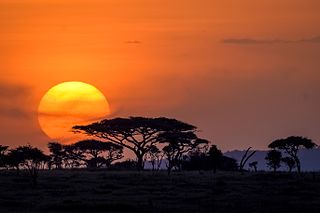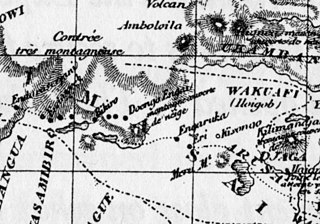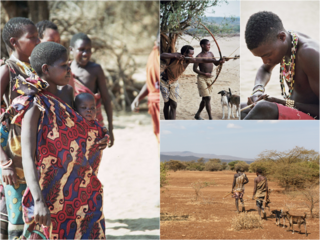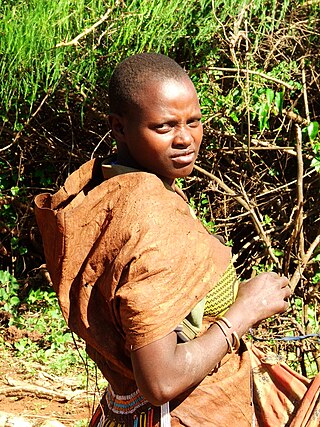Related Research Articles

The Maasai are a Nilotic ethnic group inhabiting northern, central and southern Kenya and northern Tanzania, near the African Great Lakes region. The Maasai speak the Maa language, a member of the Nilotic language family that is related to the Dinka, Kalenjin and Nuer languages. Except for some elders living in rural areas, most Maasai people speak the official languages of Kenya and Tanzania, being Swahili and English.

The Serengeti ecosystem is a geographical region in Africa, spanning the Mara and Arusha Regions of Tanzania. The protected area within the region includes approximately 30,000 km2 (12,000 sq mi) of land, including the Serengeti National Park and several game reserves. The Serengeti hosts the world's most massive land animal migration, which helps secure it as one of the Seven Natural Wonders of Africa.

The Serengeti National Park is a large national park in northern Tanzania that stretches over 14,763 km2 (5,700 sq mi). It is located in eastern Mara Region and northeastern Simiyu Region and contains over 1,500,000 hectares of virgin savanna. The park was established in 1940.
The Nilotic peoples are people indigenous to the Nile Valley who speak Nilotic languages. They inhabit South Sudan, Sudan, Ethiopia, Uganda, Kenya, the eastern border area of Democratic Republic of the Congo, Rwanda, Burundi and Tanzania. Among these are the Burun-speaking peoples, Teso people also known as Iteso or people of Teso, Karo peoples, Luo peoples, Ateker peoples, Kalenjin peoples, Karamojong people also known as the Karamojong or Karimojong, Datooga, Dinka, Nuer, Atwot, Lotuko, and the Maa-speaking peoples.

The Kalenjin are a group of tribes indigenous to East Africa, residing mainly in what was formerly the Rift Valley Province in Kenya and the Eastern slopes of Mount Elgon in Uganda. They number 6,358,113 individuals per the Kenyan 2019 census and an estimated 273,839 in Uganda according to the 2014 census mainly in Kapchorwa, Kween and Bukwo districts.

Ngorongoro Conservation Area is a protected area and a UNESCO World Heritage Site located in Ngorongoro District, 180 km (110 mi) west of Arusha City in Arusha Region, within the Crater Highlands geological area of northeastern Tanzania. The area is named after Ngorongoro Crater, a large volcanic caldera within the area. The Ngorongoro Conservation Area Authority administers the conservation area, an arm of the Tanzanian government, and its boundaries follow the boundary of the Ngorongoro District in Arusha Region. The western portion of the park abuts the Serengeti National Park, and the area comprising the two parks and Kenya's Maasai Mara game reserve is home to Great Migration, a massive annual migration of millions of wildebeest, zebras, gazelles, and other animals. The conservation area also contains Olduvai Gorge, one of the most important paleoanthropological sites in the world.

Lake Eyasi is a lake located in Karatu District of Arusha Region in north Tanzania. Lake Eyasi is the largest body of water in Arusha region. It is a seasonal shallow endorheic salt lake on the floor of the Great Rift Valley at the base of the Serengeti Plateau, just south of the Serengeti National Park and immediately southwest of the Ngorongoro Crater in the Crater Highlands of Tanzania. The lake is elongated, orientated southwest to northeast, and lies in the Eyasi-Wembere branch of the Great Rift Valley.

Arusha Region is one of Tanzania's 31 administrative regions and is located in the northeast of the country. The region's capital and largest city is the city of Arusha. The region is bordered by Kajiado County and Narok County in Kenya to the north, the Kilimanjaro Region to the east, the Manyara and Singida Regions to the south, and the Mara and Simiyu regions to the west. Arusha Region is home to Ngorongoro Conservation Area, a UNESCO World Heritage Site. The region is comparable in size to the combined land and water areas of the state of Maryland in the United States.

Ngorongoro District is one of seven districts in western Arusha Region of Tanzania. The district is bordered to the north by Kenya, to the east by Monduli District, the northeast by Longido District, and to the south by the Karatu District. The western border is the Serengeti District in Mara Region. Ngorongoro District is home to the Ngorongoro Crater and was named after it. It covers an area of 14,036 km2 (5,419 sq mi). The district is comparable in size to the land area of Timor Leste. The administrative seat is the town of Loliondo. The district is home to the Ngorongoro Conservation Area which is a UNESCO World Heritage Site. The district is also home to the third tallest mountain in the country, Mount Loolmalasin. According to the 2002 Tanzania National Census, the population of the Ngorongoro Region was 129,776. By 2012, the population of the district was 174,278. By 2022, the population had grown to 273,549.

Engaruka is an abandoned system of ruins located in northwest Monduli District in central Arusha Region. The site is in geographical range of the Great Rift Valley of northern Tanzania. Situated in the Monduli District, it is famed for its irrigation and cultivation structures. It is considered one of the most important Iron Age archaeological sites in Tanzania. The site is located in the ward of Engaruka. The site is registered as one of the National Historic Sites of Tanzania.

The Iraqw People are a Cushitic ethnic group inhabiting the northern Tanzanian regions. They are believed to have originated from the southwestern Arusha and Manyara regions of Tanzania, near the Rift Valley. The Iraqw people then settled in the southeast of Ngorongoro Crater in northern Karatu District, Arusha Region, where the majority of them still reside. In the Manyara region, the Iraqw are a major ethnic group, specifically in Mbulu District, Babati District and Hanang District.

The Hadza, or Hadzabe, are a protected hunter-gatherer Tanzanian indigenous ethnic group from Baray ward in southwest Karatu District of the Arusha Region. They live around the Lake Eyasi basin in the central Rift Valley and in the neighboring Serengeti Plateau. As of 2015, there are between 1,200 and 1,300 Hadza people living in Tanzania. However, only around 400 Hadza still survive exclusively based on the traditional means of foraging. Additionally, the increasing impact of tourism and encroaching pastoralists pose serious threats to the continuation of their traditional way of life.

The Barabaig(Wabarabaig, in Swahili) are a nomadic tribe of the Datooga people based in the northern volcanic highlands near Mount Hanang in Manyara Region, Tanzania, speaking the eponymous dialect of the Datooga language. Their population is about 50,000.
The Alagwa are a Cushitic ethnic group mostly based in the Kondoa District of the Dodoma Region in central Tanzania, an area well known for rock art. Smaller numbers of Alagwa reside in the Hanang district of the Manyara Region in Tanzania, as well. They speak the Alagwa language as a mother tongue, which belongs to the South Cushitic branch of the Afro-Asiatic family. In 2022, the Alagwa population was estimated to number 52,816 individuals, and Mous (2016) estimates the number of speakers to be slightly over 10,000.

Iraqw is a Cushitic language spoken in Tanzania in the Arusha and Manyara Regions. It is expanding in numbers as the Iraqw people absorb neighbouring ethnic groups. The language has many Datooga loanwords, especially in poetic language. The Gorowa language, to the south, shares numerous similarities and is sometimes considered a dialect.
Conservation refugees are people who are displaced from their native lands when conservation areas, such as parks and other protected areas, are created.
Datooga is a Nilotic language or dialect cluster of the Southern Nilotic group. It is spoken by the Datooga people of the Great Rift Valley of Tanzania. The Sukuma name Taturu is also sometimes used in English; the Swahili name Mang'ati comes from Maasai, where it means "enemy". However, it is not considered offensive to the Datooga, as there is a degree of pride in being the historic enemy of the Maasai, and Mang'ati has become the standard name for the group in Swahili. In addition, numerous tribal and dialectal names may be found for the people or language as a whole.
The Kalenjin people are an ethnolinguistic group indigenous to East Africa, with a presence, as dated by archaeology and linguistics, that goes back many centuries. Their history is therefore deeply interwoven with those of their neighboring communities as well as with the histories of Kenya, Uganda, Tanzania, South Sudan, and Ethiopia.
The Loikop people, also known as Wakuafi, Kor, Mu-Oko, Muoko/Ma-Uoko and Mwoko, were a tribal confederacy who inhabited present-day Kenya in the regions north and west of Mount Kenya and east and south of Lake Turkana. The area is roughly conterminous with Samburu and Laikipia Counties and portions of Baringo, Turkana and (possibly) Meru Counties. The group spoke a common tongue related to the Maasai language, and typically herded cattle. The Loikop occasionally interacted with the Cushitic, Bantu, and Chok peoples. The confederacy had dispersed by the 21st century.
Mutai is a term used by the Maa-speaking communities of Kenya to describe a period of wars, usually triggered by disease and/or drought affecting widespread areas of the Rift Valley region of Kenya. According to Samburu and Maasai tradition, two periods of Mutai occurred during the nineteenth century. The second Mutai lasted from the 1870s to the 1890s.
References
- ↑ Though the warfare in Ngorongoro crater that led to the expulsion of the Datoga is purported to have taken place over only a few days (Wada, 1975, p. 59), the 15-year approximation of when the battle took place is based upon the fact that one of the paths that the Masai took into the crater was named after an age set (Dawati), whose circumcisions occurred in 1836. Assuming a new age set would occur at most 15 years later, the date range of 1836-1851 is given (Mulder et al., 1989, p.34).
- ↑ Mulder, M.B., Sieff, D. & Merus, M. (1989). "Disturbed ancestors: Datoga history in the Ngorongoro Crater." Swara, 12(2), 32–35
- ↑ The general area around the southeastern shore of Lake Victoria that is inhabited by the Sukuma people.
- 1 2 3 Wada, S. (1975). Political history of Mbulu district: Power struggles and territorial grouping of medicine men. Kyoto University African Studies, 9, p. 59.
- ↑ Tomikawa, M. (1979). The migrations and inter-tribal relations of the pastoral Datoga. Senri Ethnological Studies, 3, p. 20.
- 1 2 Tomikawa, M. (1979). The migrations and inter-tribal relations of the pastoral Datoga. Senri Ethnological Studies, 3, p. 21.
- ↑ Mulder, M.B., Sieff, D. & Merus, M. (1989). "Disturbed ancestors: Datoga history in the Ngorongoro Crater." Swara, 12(2), p. 33.
- ↑ Wada, S. (1975). Political history of Mbulu district: Power struggles and territorial grouping of medicine men. Kyoto University African Studies, 9, p.59.
- ↑ Tomikawa, M. (1979). The migrations and inter-tribal relations of the pastoral Datoga. Senri Ethnological Studies, 3, p. 23.
- 1 2 Thornton, R. J. (1980). Space, time, and culture among the Iraqw of Tanzania. New York, NY: Academic Press, Inc., p. 78
- ↑ Wada, S. (1975). Political history of Mbulu district: Power struggles and territorial grouping of medicine men. Kyoto University African Studies, 9, p. 60.
- ↑ Mous, M.P.G.M. (1992). "A grammar of Iraqw." (Doctoral Dissertation), p. 2.
- ↑ Rekdal, O. B. & Blystad, A. (1999). ‘We are as sheep & goats: Iraqw & Datooga discourses on fortune, failure, & the future. In D.M. Anderson & V. Broch-Due (Eds.), The poor are not us: Poverty & pastoralism in Eastern Africa. Athens, OH: Ohio University Press, p. 129.
- 1 2 3 4 5 Jellicoe, M., Sima, V., & Sombi, J. (1967). "The shrine in the desert." Transition, (34), p. 43.
- ↑ Shetler, J.B. (2007). Imagining Serengeti: A history of landscape memory in Tanzania from earliest time to the Present. Athens, OH: Ohio University Press, p. 146.
- 1 2 Jellicoe, M., Sima, V., & Sombi, J. (1967). "The shrine in the desert." Transition, (34), p. 44.
- 1 2 Manger, L. (2000). "East African pastoralism and underdevelopment: An introduction." In L. Manger, J. Helland, B. Tache, A. Tolera, A. Ghaffar, M. Ahmed, and S. Shalazi (Eds.), Pastoralists and Environment: Experiences from the Greater Horn of Africa (pp. 2-10).
- ↑ Blystad, A. (2004). "On HIV, sex and respect: Local-global discourse encounters among the Datoga of Tanzania." African Sociological Review, 8(1), p. 47.
- ↑ Blystad, A. (2004). "On HIV, sex and respect: Local-global discourse encounters among the Datoga of Tanzania." African Sociological Review, 8(1), p. 48.
- ↑ Blystad, A. (2004). "On HIV, sex and respect: Local-global discourse encounters among the Datoga of Tanzania." African Sociological Review, 8(1), p. 54.
- ↑ Thornton, R. J. (1980). Space, time, and culture among the Iraqw of Tanzania. New York, NY: Academic Press, Inc., p. 123.
- ↑ Thornton, R. J. (1980). Space, time, and culture among the Iraqw of Tanzania. New York, NY: Academic Press, Inc., p. 123
- 1 2 3 Tomikawa, M. (1979). The migrations and inter-tribal relations of the pastoral Datoga. Senri Ethnological Studies, 3, p. 24.
- ↑ A Datoga sub-tribe.
- ↑ Wada, S. (1975). Political history of Mbulu district: Power struggles and territorial grouping of medicine men. Kyoto University African Studies, 9, p. 61.
- ↑ Tomikawa, M. (1979). The migrations and inter-tribal relations of the pastoral Datoga. Senri Ethnological Studies, 3, p. 19.
- ↑ Considered the most important politico-religious members of the Bajuta (Tomikawa, 1979, p. 19).
- 1 2 Wada, S. (1975). Political history of Mbulu district: Power struggles and territorial grouping of medicine men. Kyoto University African Studies, 9, p. 62.
- 1 2 Thornton, R. J. (1980). Space, time, and culture among the Iraqw of Tanzania. New York, NY: Academic Press, Inc., p. 79
- ↑ Tomikawa, M. (1979). The migrations and inter-tribal relations of the pastoral Datoga. Senri Ethnological Studies, 3, p. 24
- ↑ Rekdal, O. B. & Blystad, A. (1999). ‘We are as sheep & goats: Iraqw & Datooga discourses on fortune, failure, & the future. In D.M. Anderson & V. Broch-Due (Eds.), The poor are not us: Poverty & pastoralism in Eastern Africa (pp. 125-146). Athens, OH: Ohio University Press., p. 128